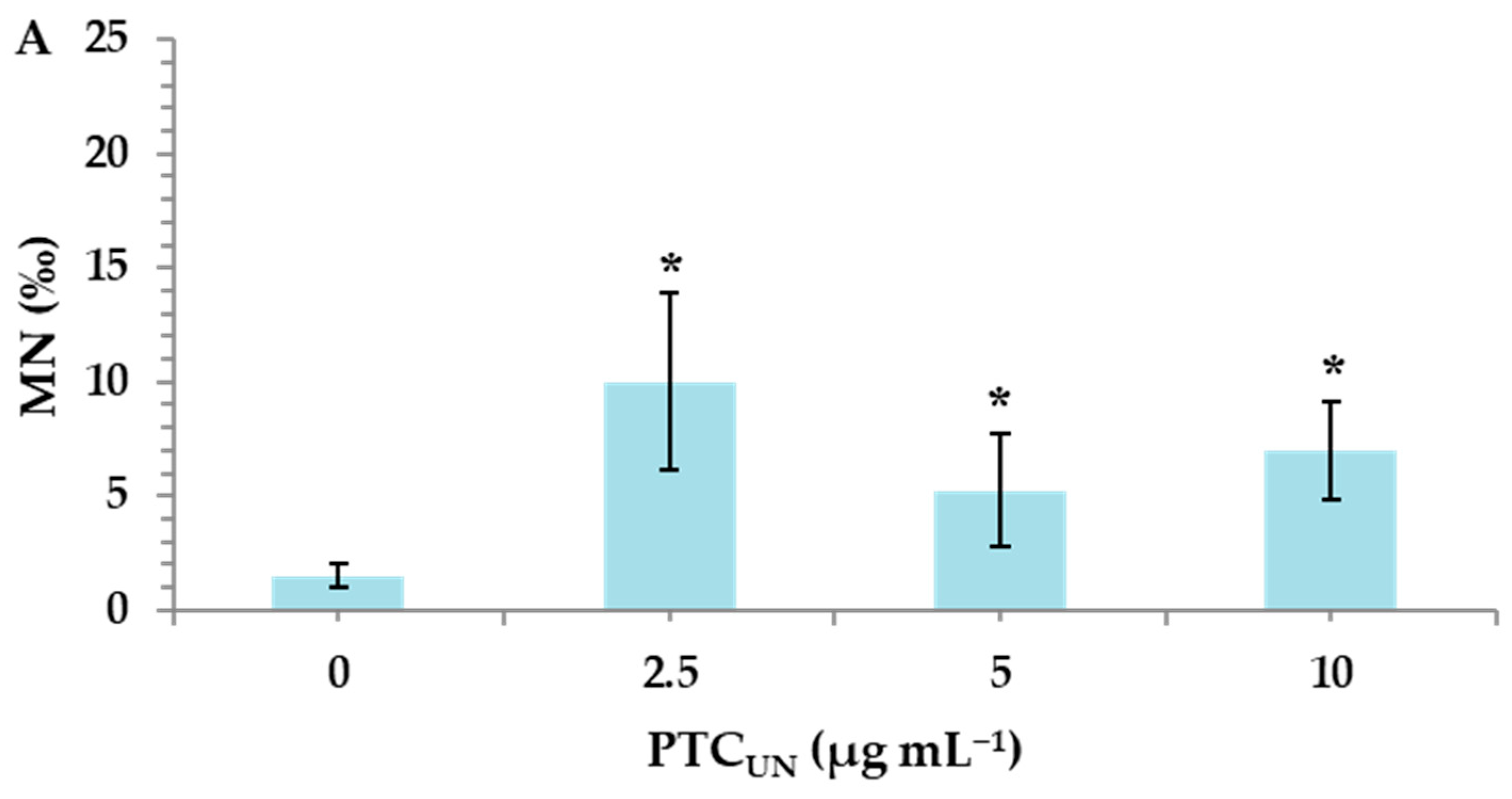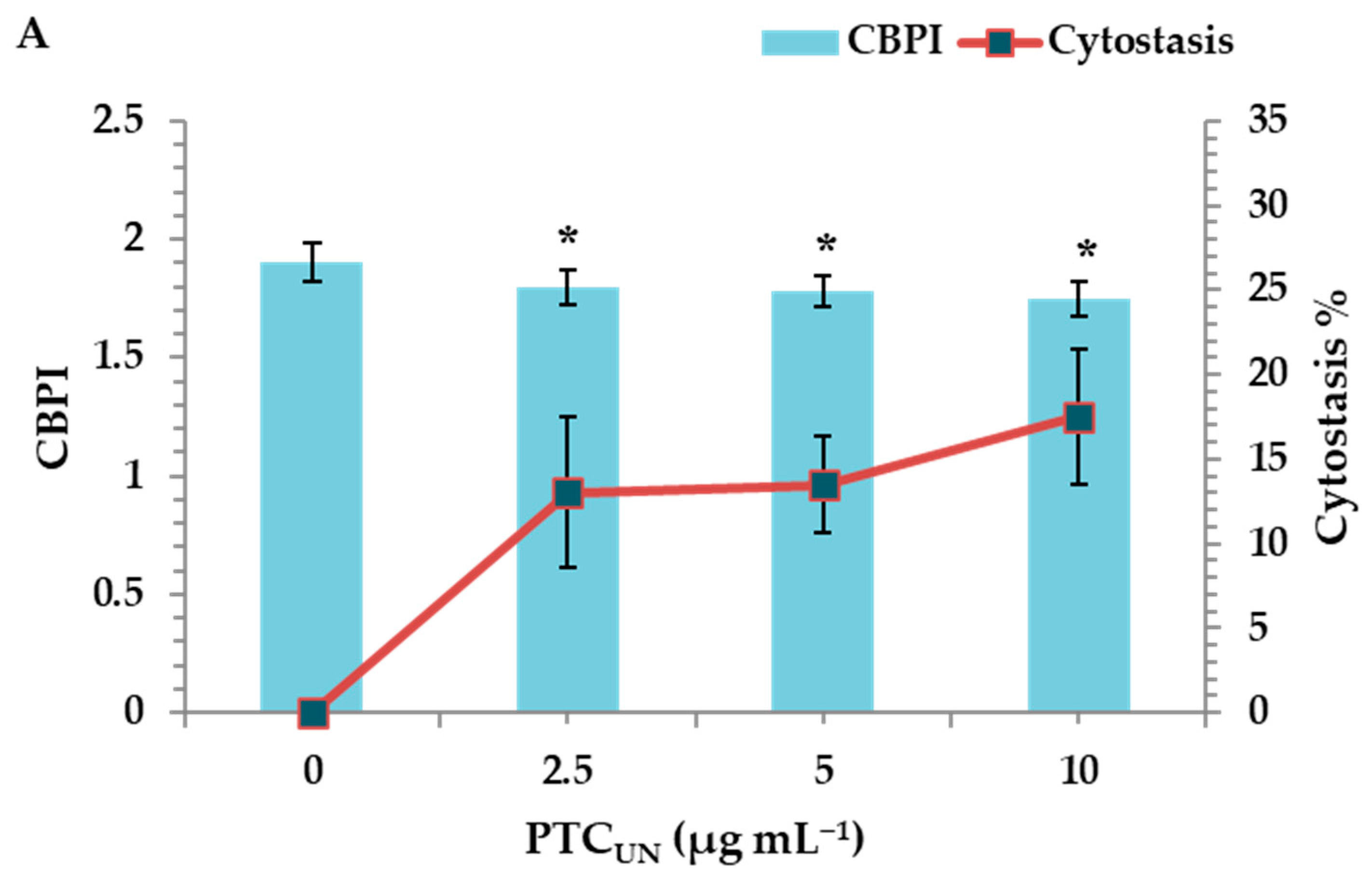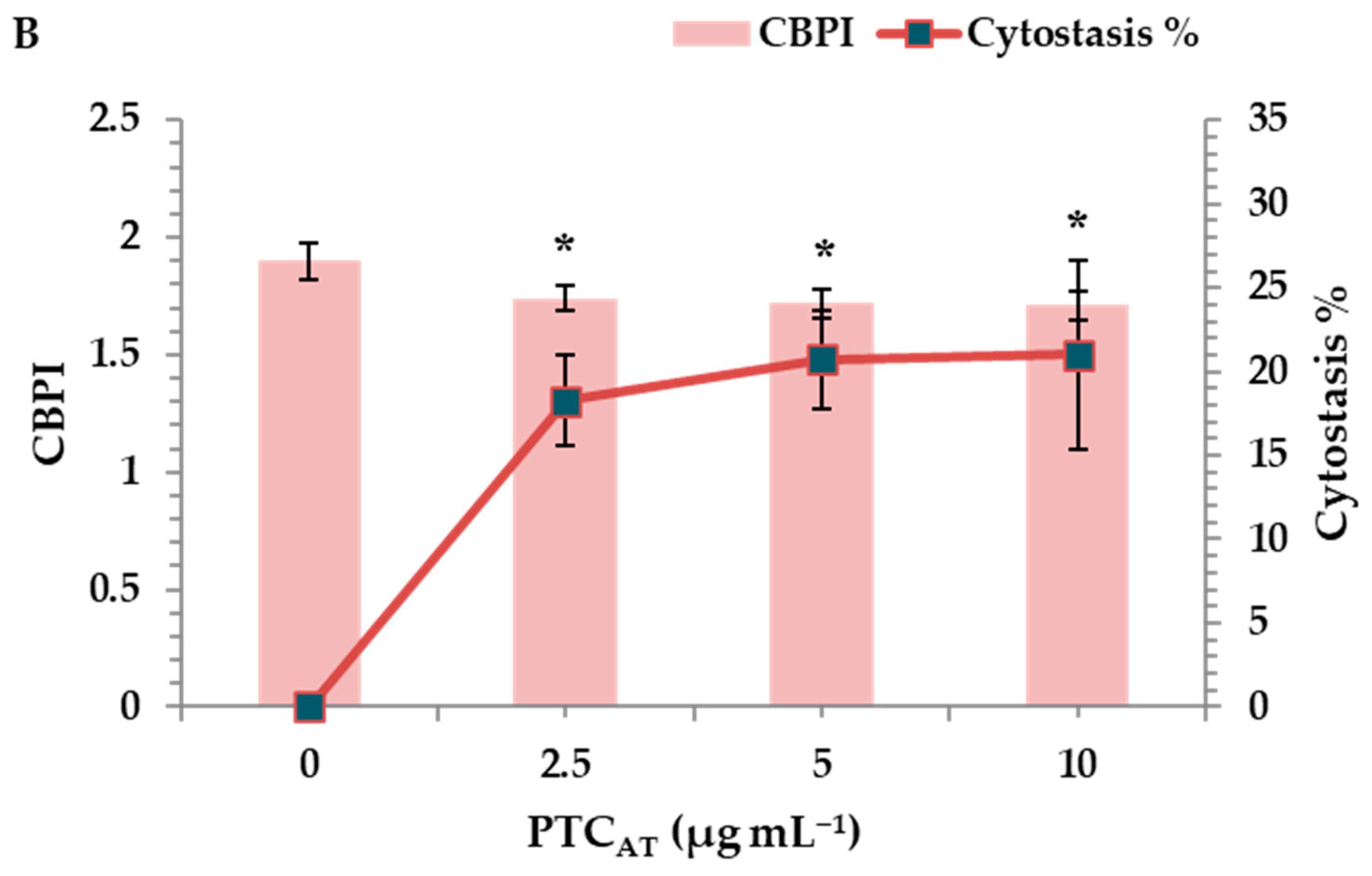Evaluating the Cytotoxic, Genotoxic, and Toxic Potential of Pyrolytic Tire Char Using Human Lymphocytes and a Bacterial Biosensor
Abstract
1. Introduction
2. Materials and Methods
2.1. Chemicals and Reagents
2.2. PAH Extraction and GC-MS Analysis
2.3. Determination of Major Elements by X-Ray Fluorescence
2.4. Sample Preparation
2.5. Aliivibrio Fischeri Bioluminescence Inhibition Test
2.6. CBMN Assay in Human Lymphocytes In Vitro
2.6.1. Ethics Statement
2.6.2. CBMN Assay Application
2.7. Statistical Analysis
3. Results
3.1. Determination of PAHs in PTCUN and PTCAT
3.2. Determination of Major Elements of PTCUN and PTCAT
3.3. Toxic Effects of PTCUN and PTCAT on Aliivibrio Fischeri
3.4. CBMN on Human Lymphocyte Cultures
3.4.1. Genotoxic Effects of PTCUN and PTCAT
3.4.2. Cytotoxic Effects of PTCUN and PTCAT
4. Discussion
5. Conclusions
Supplementary Materials
Author Contributions
Funding
Institutional Review Board Statement
Informed Consent Statement
Data Availability Statement
Conflicts of Interest
Abbreviations
| WT | Waste Tire |
| PTC | Pyrolytic Tire Char |
| PTCUN | Untreated Pyrolytic Tire Char |
| PTCAT | Acid Treated Pyrolytic Tire Char |
| PAHs | Polycyclic Aromatic Hydrocarbons |
| CBMN | Cytokinesis Block MicroNucleus |
| MN | Micronuclei |
| CBPI | Cytokinesis-Block Proliferation Index |
| BN | Binucleated |
| BNMN | Micronucleated Binucleated Cells |
| ROS | Reactive Oxygen Species |
References
- Thomas, B.S.; Gupta, R.C. A Comprehensive Review on the Applications of Waste Tire Rubber in Cement Concrete. Renew. Sustain. Energy Rev. 2016, 54, 1323–1333. [Google Scholar] [CrossRef]
- Chen, G.; Farooq, M.Z.; Sun, B.; Lin, F.; Yan, B.; Rajput, G.; Chawla, M. Pollutants Formation, Distribution, and Reaction Mechanism during WT Pyrolysis: A Review. J. Anal. Appl. Pyrolysis 2021, 157, 105218. [Google Scholar] [CrossRef]
- Thomas, B.S.; Guapta, R.C.; Panicker, V.J. Recycling of Waste Tire Rubber as Aggregate in Concrete: Durability-Related Performance. J. Clean. Prod. 2016, 112, 504–513. [Google Scholar] [CrossRef]
- Niezgoda, A.; Deng, Y.; Sabatier, F.; Ansart, R. From End-of-Life Tires to Storable Energy Carriers. J. Environ. Manag. 2020, 276, 111318. [Google Scholar] [CrossRef] [PubMed]
- Martínez, J.D.; Puy, N.; Murillo, R.; García, T.; Navarro, M.V.; Mastral, A.M. Waste Tyre Pyrolysis—A Review. Renew. Sustain. Energy Rev. 2013, 23, 179–213. [Google Scholar] [CrossRef]
- Abnisa, F.; Wan Daud, W.M.A. Optimization of Fuel Recovery through the Stepwise Co-Pyrolysis of Palm Shell and Scrap Tire. Energy Convers. Manag. 2015, 99, 334–345. [Google Scholar] [CrossRef]
- Chen, B.; Zheng, D.; Xu, R.; Leng, S.; Han, L.; Zhang, Q.; Liu, N.; Dai, C.; Wu, B.; Yu, G.; et al. Disposal Methods for Used Passenger Car Tires: One of the Fastest Growing Solid Wastes in China. Green Energy Environ. 2022, 7, 1298–1309. [Google Scholar] [CrossRef]
- Guo, L.; Wang, C.; Lv, D.; Ren, D.; Zhai, T.; Sun, C.; Liu, H. Rubber Reclamation with High Bond-Breaking Selectivity Using a Low-Temperature Mechano-Chemical Devulcanization Method. J. Clean. Prod. 2021, 279, 123266. [Google Scholar] [CrossRef]
- Martínez, J.D.; Campuzano, F.; Cardona-Uribe, N.; Arenas, C.N.; Muñoz-Lopera, D. Waste Tire Valorization by Intermediate Pyrolysis Using a Continuous Twin-Auger Reactor: Operational Features. Waste Manag. 2020, 113, 404–412. [Google Scholar] [CrossRef]
- Arya, S.; Sharma, A.; Rawat, M.; Agrawal, A. Tyre Pyrolysis Oil as an Alternative Fuel: A Review. Mater. Today Proc. 2020, 28, 2481–2484. [Google Scholar] [CrossRef]
- Xu, S.; Lai, D.; Zeng, X.; Zhang, L.; Han, Z.; Cheng, J.; Wu, R.; Mašek, O.; Xu, G. Pyrolysis Characteristics of Waste Tire Particles in Fixed-Bed Reactor with Internals. Carbon. Resour. Convers. 2018, 1, 228–237. [Google Scholar] [CrossRef]
- Aylón, E.; Fernández-Colino, A.; Murillo, R.; Navarro, M.V.; García, T.; Mastral, A.M. Valorisation of Waste Tyre by Pyrolysis in a Moving Bed Reactor. Waste Manag. 2010, 30, 1220–1224. [Google Scholar] [CrossRef] [PubMed]
- Mastral, A.M.; Murillo, R.; Callén, M.S.; García, T.; Snape, C.E. Influence of Process Variables on Oils from Tire Pyrolysis and Hydropyrolysis in a Swept Fixed Bed Reactor. Energy Fuels 2000, 14, 739–744. [Google Scholar] [CrossRef]
- De Marco Rodriguez, I.; Laresgoiti, M.F.; Cabrero, M.A.; Torres, A.; Chomón, M.J.; Caballero, B. Pyrolysis of Scrap Tyres. Fuel Process. Technol. 2001, 72, 9–22. [Google Scholar] [CrossRef]
- González, J.F.; Encinar, J.M.; Canito, J.L.; Rodríguez, J.J. Pyrolysis of Automobile Tyre Waste. Influence of Operating Variables and Kinetics Study. J. Anal. Appl. Pyrolysis 2001, 58–59, 667–683. [Google Scholar] [CrossRef]
- Murillo, R.; Aylón, E.; Navarro, M.V.; Callén, M.S.; Aranda, A.; Mastral, A.M. The Application of Thermal Processes to Valorise Waste Tyre. Fuel Process. Technol. 2006, 87, 143–147. [Google Scholar] [CrossRef]
- Aylón, E.; Callén, M.S.; López, J.M.; Mastral, A.M.; Murillo, R.; Navarro, M.V.; Stelmach, S. Assessment of Tire Devolatilization Kinetics. J. Anal. Appl. Pyrolysis 2005, 74, 259–264. [Google Scholar] [CrossRef]
- Czajczyńska, D.; Anguilano, L.; Ghazal, H.; Krzyżyńska, R.; Reynolds, A.J.; Spencer, N.; Jouhara, H. Potential of Pyrolysis Processes in the Waste Management Sector. Therm. Sci. Eng. Prog. 2017, 3, 171–197. [Google Scholar] [CrossRef]
- Khalid, M.Y.; Arif, Z.U.; Hossain, M.; Umer, R. Recycling of Wind Turbine Blades through Modern Recycling Technologies: A Road to Zero Waste. Renew. Energy Focus. 2023, 44, 373–389. [Google Scholar] [CrossRef]
- Yaqoob, H.; Teoh, Y.H.; Sher, F.; Jamil, M.A.; Murtaza, D.; Al Qubeissi, M.; Ui Hassan, M.; Mujtaba, M.A. Current Status and Potential of Tire Pyrolysis Oil Production as an Alternative Fuel in Developing Countries. Sustainability 2021, 13, 3214. [Google Scholar] [CrossRef]
- Lian, F.; Song, Z.; Liu, Z.; Zhu, L.; Xing, B. Mechanistic Understanding of Tetracycline Sorption on Waste Tire Powder and Its Chars as Affected by Cu2+ and pH. Environ. Pollut. 2013, 178, 264–270. [Google Scholar] [CrossRef] [PubMed]
- Ren, Q.; He, L.; Hu, S.; Su, S.; Wang, Y.; Jiang, L.; Xiang, J. The Structural Characteristics of Waste Tire Chars at Different Pyrolysis Temperatures. IOP Conf. Ser. Earth Environ. Sci. 2021, 657, 012005. [Google Scholar] [CrossRef]
- Han, W.; Han, D.; Chen, H. Pyrolysis of Waste Tires: A Review. Polymers 2023, 15, 1604. [Google Scholar] [CrossRef] [PubMed]
- Makrigianni, V.; Giannakas, A.; Deligiannakis, Y.; Konstantinou, I. Adsorption of Phenol and Methylene Blue from Aqueous Solutions by Pyrolytic Tire Char: Equilibrium and Kinetic Studies. J. Environ. Chem. Eng. 2015, 3, 574–582. [Google Scholar] [CrossRef]
- Bonassi, S.; El-Zein, R.; Bolognesi, C.; Fenech, M. Micronuclei Frequency in Peripheral Blood Lymphocytes and Cancer Risk: Evidence from Human Studies. Mutagenesis 2011, 26, 93–100. [Google Scholar] [CrossRef]
- Martins, R.S.L.; Abessa, D.M.S.; Fornaro, A.; Borrely, S.I. Rainwater Toxicity and Contamination Study from São Paulo Metropolitan Region, Brazil. Environ. Monit. Assess. 2014, 186, 1183–1194. [Google Scholar] [CrossRef]
- OECD. Test No. 487: In Vitro Mammalian Cell Micronucleus Test; OECD Guidelines for the Testing of Chemicals, Section 4; OECD Publishing: Paris, France, 2023; ISBN 978-92-64-26486-1. [Google Scholar]
- Fabbri, D.; Rombolà, A.G.; Torri, C.; Spokas, K.A. Determination of polycyclic aromatic hydrocarbons in biochar and biochar amended soil. J. Anal. Appl. Pyrol. 2013, 103, 60–67. [Google Scholar] [CrossRef]
- Surrallés, J.; Carbonell, E.; Marcos, R.; Degrassi, F.; Antoccia, A.; Tanzarella, C. A Collaborative Study on the Improvement of the Micronucleus Test in Cultured Human Lymphocytes. Mutagenesis 1992, 7, 407–410. [Google Scholar] [CrossRef]
- Fenech, M. The advantages and disadvantages of the cytokinesis-block micronucleus method. Mutat. Res. 1997, 392, 11–18. [Google Scholar] [CrossRef]
- Fenech, M.; Chang, W.P.; Kirsch-Volders, M.; Holland, N.; Bonassi, S.; Zeiger, E. Human MicronNucleus project HUMN Project: Detailed Description of the Scoring Criteria for the Cytokinesis-Block Micronucleus Assay Using Isolated Human Lymphocyte Cultures. Mutat. Res. 2003, 534, 65–75. [Google Scholar] [CrossRef]
- Surrallés, J.; Xamena, N.; Creus, A.; Catalán, J.; Norppa, H.; Marcos, R. Induction of Micronuclei by Five Pyrethroid Insecticides in Whole-Blood and Isolated Human Lymphocyte Cultures. Mutat. Res. 1995, 341, 169–184. [Google Scholar] [CrossRef] [PubMed]
- Lorge, E.; Thybaud, V.; Aardema, M.J.; Oliver, J.; Wakata, A.; Lorenzon, G.; Marzin, D. SFTG international collaborative study on in vitro micronucleus test I. General conditions and overall conclusions of the study. Mutat. Res. 2006, 4, 13–36. [Google Scholar] [CrossRef] [PubMed]
- Wang, Y.; Li, X.; Yang, H.; Wu, Y.; Pu, Q.; He, W.; Li, X. A Review of Tire Wear Particles: Occurrence, Adverse Effects, and Control Strategies. Ecotoxicol. Environ. Saf. 2024, 283, 116782. [Google Scholar] [CrossRef] [PubMed]
- Konstantinova, E.; Minkina, T.; Sushkova, S.; Antonenko, E.; Konstantinov, A. Levels, sources, and toxicity assessment of polycyclic aromatic hydrocarbons in urban topsoils of an intensively developing Western Siberian city. Environ. Geochem. Health. 2020, 42, 325–341. [Google Scholar] [CrossRef]
- Niesler, M.; Stecko, J.; Gierad, D.; Nowak, M.; Stelmach, S. Experimental Production of Iron-Bearing Sinters Using Chars from Waste Car Tires. Processes 2023, 11, 231. [Google Scholar] [CrossRef]
- Bernardo, M.; Mendes, S.; Lapa, N.; Gonçalves, M.; Mendes, B.; Pinto, F.; Lopes, H. Leaching Behaviour and Ecotoxicity Evaluation of Chars from the Pyrolysis of Forestry Biomass and Polymeric Materials. Ecotoxicol. Environ. Saf. 2014, 107, 9–15. [Google Scholar] [CrossRef][Green Version]
- Burdová, H.; Polanská Nebeská, D.; Kwoczynski, Z.; Žižková, L.; Neubertová, V.; Snow, J.; Pilnaj, D.; Baka, M.; Al Souki, K.S. A Comprehensive Evaluation of the Environmental and Health Risks Associated with the Potential Utilization of Chars Produced from Tires, Electro-Waste Plastics and Biomass. Environ. Res. 2025, 264, 120390. [Google Scholar] [CrossRef]
- Pal, A.K.; Bello, D.; Cohen, J.; Demokritou, P. Implications of in Vitro Dosimetry on Toxicological Ranking of Low Aspect Ratio Engineered Nanomaterials. Nanotoxicology 2015, 9, 871–885. [Google Scholar] [CrossRef]
- Poma, A.; Vecchiotti, G.; Colafarina, S.; Zarivi, O.; Arrizza, L.; Di Carlo, P.; Di Cola, A. Exposure to Particle Debris Generated from Passenger and Truck Tires Induces Different Genotoxicity and Inflammatory Responses in the RAW 264.7 Cell Line. PLoS ONE 2019, 14, e0222044. [Google Scholar] [CrossRef]
- Lesniak, A.; Fenaroli, F.; Monopoli, M.P.; Åberg, C.; Dawson, K.A.; Salvati, A. Effects of the Presence or Absence of a Protein Corona on Silica Nanoparticle Uptake and Impact on Cells. ACS Nano 2012, 6, 5845–5857. [Google Scholar] [CrossRef]
- Lassila, T.; Hokkanen, J.; Aatsinki, S.-M.; Mattila, S.; Turpeinen, M.; Tolonen, A. Toxicity of Carboxylic Acid-Containing Drugs: The Role of Acyl Migration and CoA Conjugation Investigated. Chem. Res. Toxicol. 2015, 28, 2292–2303. [Google Scholar] [CrossRef] [PubMed]
- Yang, X.; Liu, F.; Yang, S.; Yang, Y.; Wang, Y.; Li, J.; Zhao, M.; Wang, Z.; Wang, K.; He, C.; et al. Atmospheric Evolution of Environmentally Persistent Free Radicals in the Rural North China Plain: Effects on Water Solubility and PM2.5 Oxidative Potential. Atmos. Chem. Phys. 2024, 24, 11029–11043. [Google Scholar] [CrossRef]
- Hillig, D.M.; Pohlmann, J.G.; Manera, C.; Perondi, D.; Pereira, F.M.; Altafini, C.R.; Godinho, M. Evaluation of the Structural Changes of a Char Produced by Slow Pyrolysis of Biomass and of a High-Ash Coal during Its Combustion and Their Role in the Reactivity and Flue Gas Emissions. Energy 2020, 202, 117793. [Google Scholar] [CrossRef]
- Vijayanand, M.; Ramakrishnan, A.; Subramanian, R.; Issac, P.K.; Nasr, M.; Khoo, K.S.; Rajagopal, R.; Greff, B.; Wan Azelee, N.I.; Jeon, B.-H.; et al. Polyaromatic hydrocarbons (PAHs) in the water environment: A review on toxicity, microbial biodegradation, systematic biological advancements, and environmental fate. Environ. Res. 2023, 227, 115716. [Google Scholar] [CrossRef]
- Bukowska, B.; Mokra, K.; Michałowicz, J. Benzo [a] pyrene—Environmental occurrence, human exposure, and mechanisms of toxicity. Int. J. Mol. Sci. 2022, 23, 6348. [Google Scholar] [CrossRef]
- Ghodake, G.S.; Shinde, S.K.; Kadam, A.A.; Saratale, R.G.; Saratale, G.D.; Kumar, M.; Palem, R.R.; AL-Shwaiman, H.A.; Elgorban, A.M.; Syed, A.; et al. Review on Biomass Feedstocks, Pyrolysis Mechanism and Physicochemical Properties of Biochar: State-of-the-Art Framework to Speed up Vision of Circular Bioeconomy. J. Clean. Prod. 2021, 297, 126645. [Google Scholar] [CrossRef]





| PAH | PTCUT (ng g−1) | PTCAT (ng g−1) |
|---|---|---|
| Naphthalene | 312.6 | 281.9 |
| Acenaphthylene | N.D. | N.D. |
| Acenaphthene | N.D. | N.D. |
| Fluorene | N.D. | N.D. |
| Phenanthrene | 97.2 | 476.2 |
| Fluoranthene | 7.5 | N.D. |
| Anthracene | 14.9 | 23.3 |
| Pyrene | 8.9 | 30.1 |
| Chrysene | N.D. | 24.8 |
| Benzo(a)anthracene | N.D. | 20.2 |
| Benzo(b)fluoranthene | 10.7 | 14.5 |
| Benzo(k)fluoranthene | N.D. | N.D. |
| Benzo(a)pyrene | 6.2 | 40.0 |
| Indeno(1,2,3-c,d)pyrene | N.D. | N.D. |
| Dibenzo(a,h)anthracene | 7.1 | 1794.4 |
| Benzo(g,h,i)perylene | N.D. | N.D. |
| Element | PTCUN (% w/w) | PTCAT (% w/w) |
|---|---|---|
| Zn | 2.0 ± 0.4 | 3.0 ± 0.6 |
| Fe | 0.31 ± 0.03 | 0.37 ± 0.03 |
| Co | 0.11 ± 0.02 | 0.07 ± 0.01 |
| Ca | N.D. | 1.0 ± 0.4 |
Disclaimer/Publisher’s Note: The statements, opinions and data contained in all publications are solely those of the individual author(s) and contributor(s) and not of MDPI and/or the editor(s). MDPI and/or the editor(s) disclaim responsibility for any injury to people or property resulting from any ideas, methods, instructions or products referred to in the content. |
© 2025 by the authors. Licensee MDPI, Basel, Switzerland. This article is an open access article distributed under the terms and conditions of the Creative Commons Attribution (CC BY) license (https://creativecommons.org/licenses/by/4.0/).
Share and Cite
Efthimiou, I.; Dormousoglou, M.; Giova, L.; Vlastos, D.; Dailianis, S.; Antonopoulou, M.; Konstantinou, I. Evaluating the Cytotoxic, Genotoxic, and Toxic Potential of Pyrolytic Tire Char Using Human Lymphocytes and a Bacterial Biosensor. Toxics 2025, 13, 582. https://doi.org/10.3390/toxics13070582
Efthimiou I, Dormousoglou M, Giova L, Vlastos D, Dailianis S, Antonopoulou M, Konstantinou I. Evaluating the Cytotoxic, Genotoxic, and Toxic Potential of Pyrolytic Tire Char Using Human Lymphocytes and a Bacterial Biosensor. Toxics. 2025; 13(7):582. https://doi.org/10.3390/toxics13070582
Chicago/Turabian StyleEfthimiou, Ioanna, Margarita Dormousoglou, Lambrini Giova, Dimitris Vlastos, Stefanos Dailianis, Maria Antonopoulou, and Ioannis Konstantinou. 2025. "Evaluating the Cytotoxic, Genotoxic, and Toxic Potential of Pyrolytic Tire Char Using Human Lymphocytes and a Bacterial Biosensor" Toxics 13, no. 7: 582. https://doi.org/10.3390/toxics13070582
APA StyleEfthimiou, I., Dormousoglou, M., Giova, L., Vlastos, D., Dailianis, S., Antonopoulou, M., & Konstantinou, I. (2025). Evaluating the Cytotoxic, Genotoxic, and Toxic Potential of Pyrolytic Tire Char Using Human Lymphocytes and a Bacterial Biosensor. Toxics, 13(7), 582. https://doi.org/10.3390/toxics13070582













